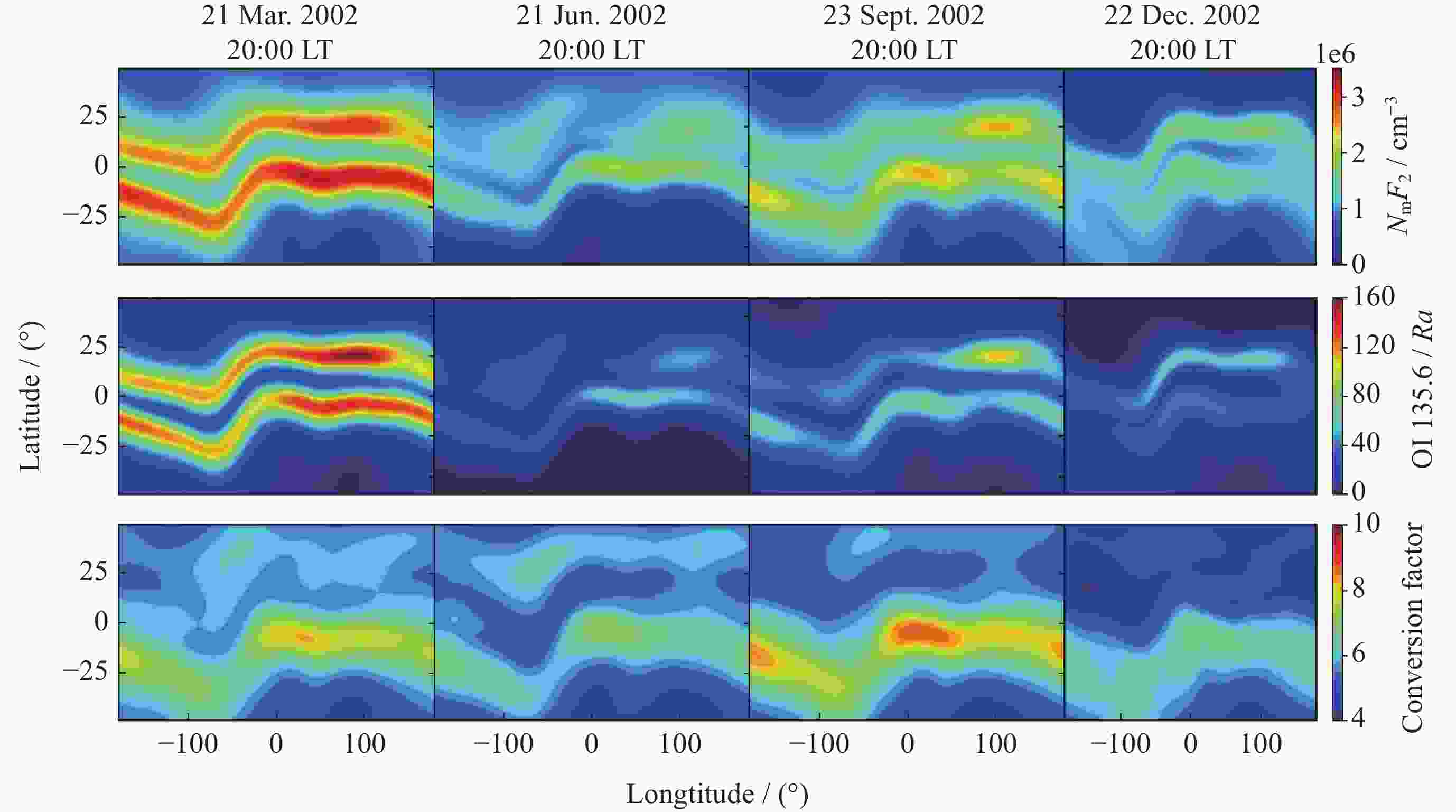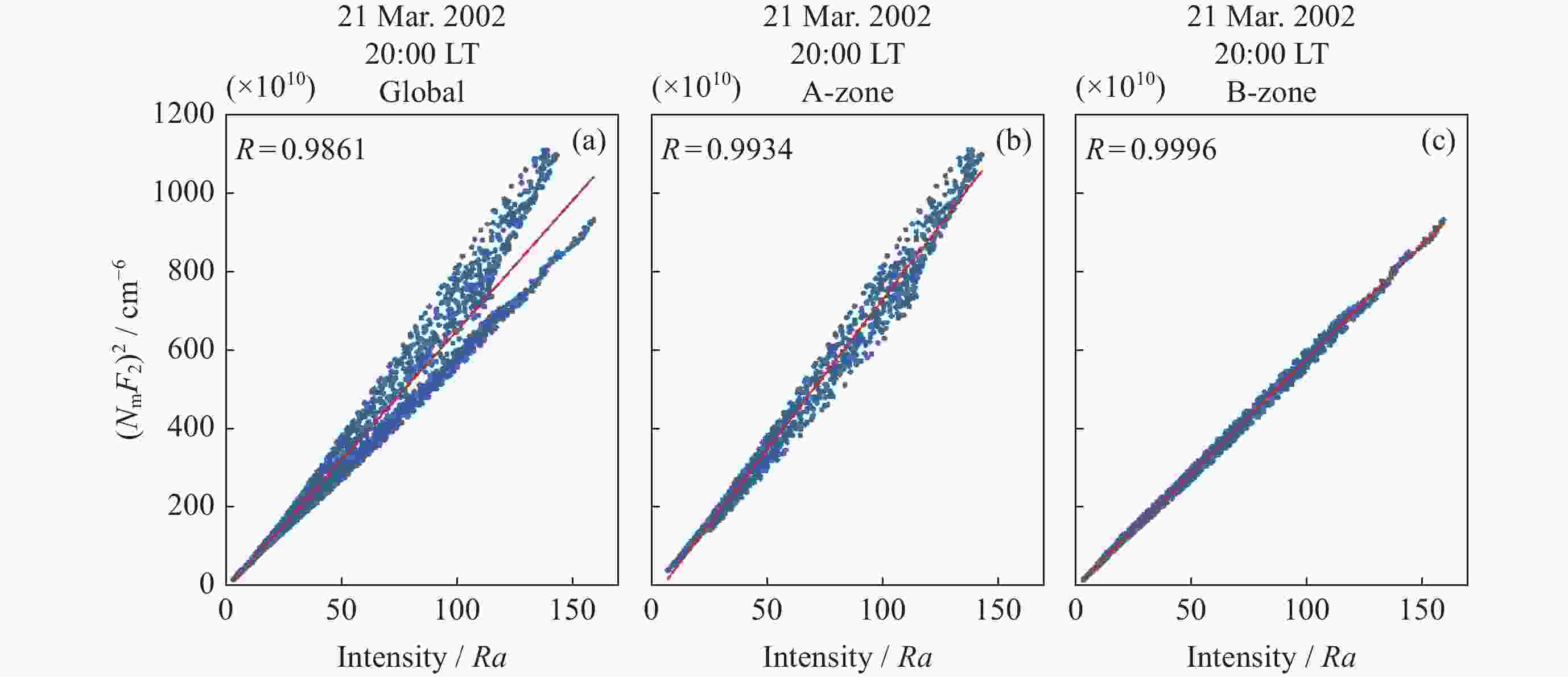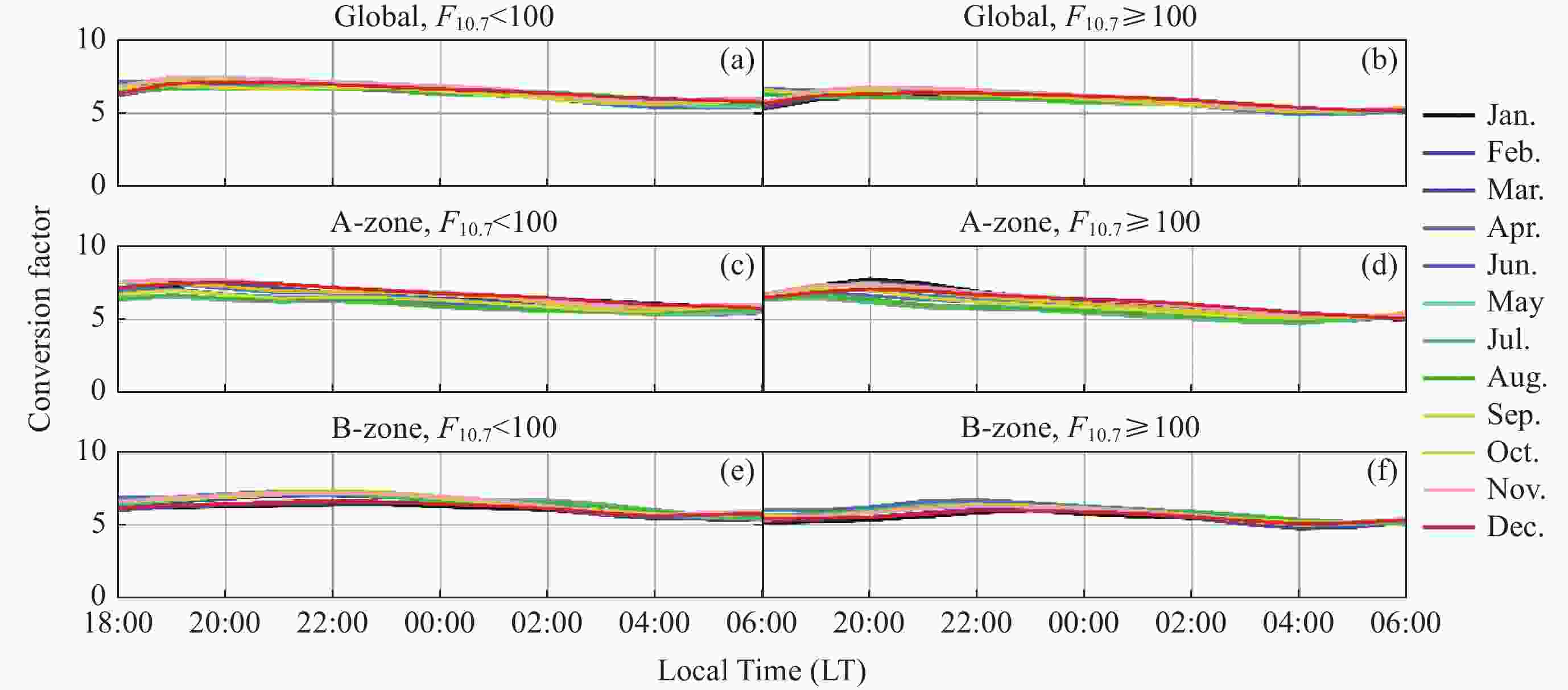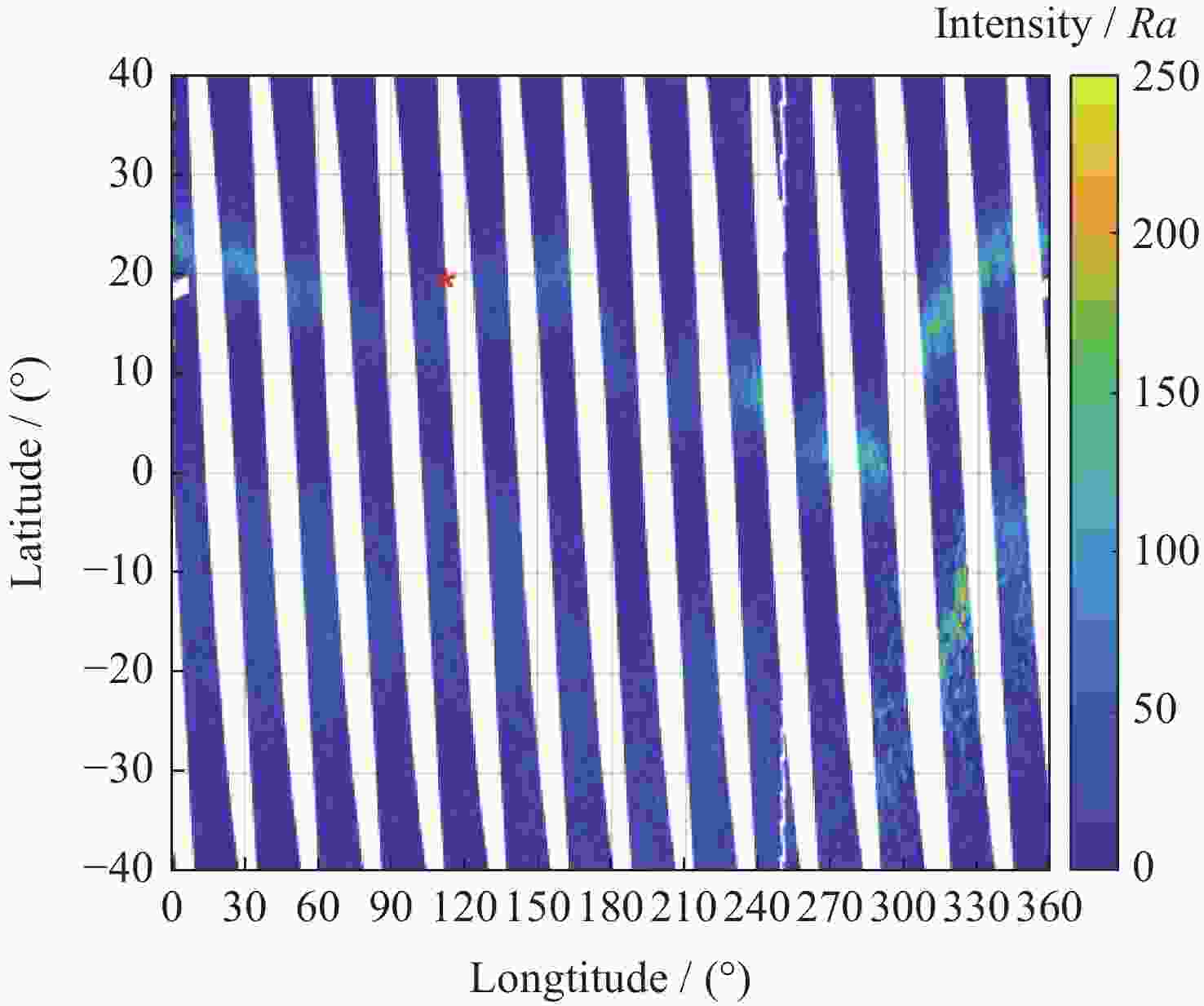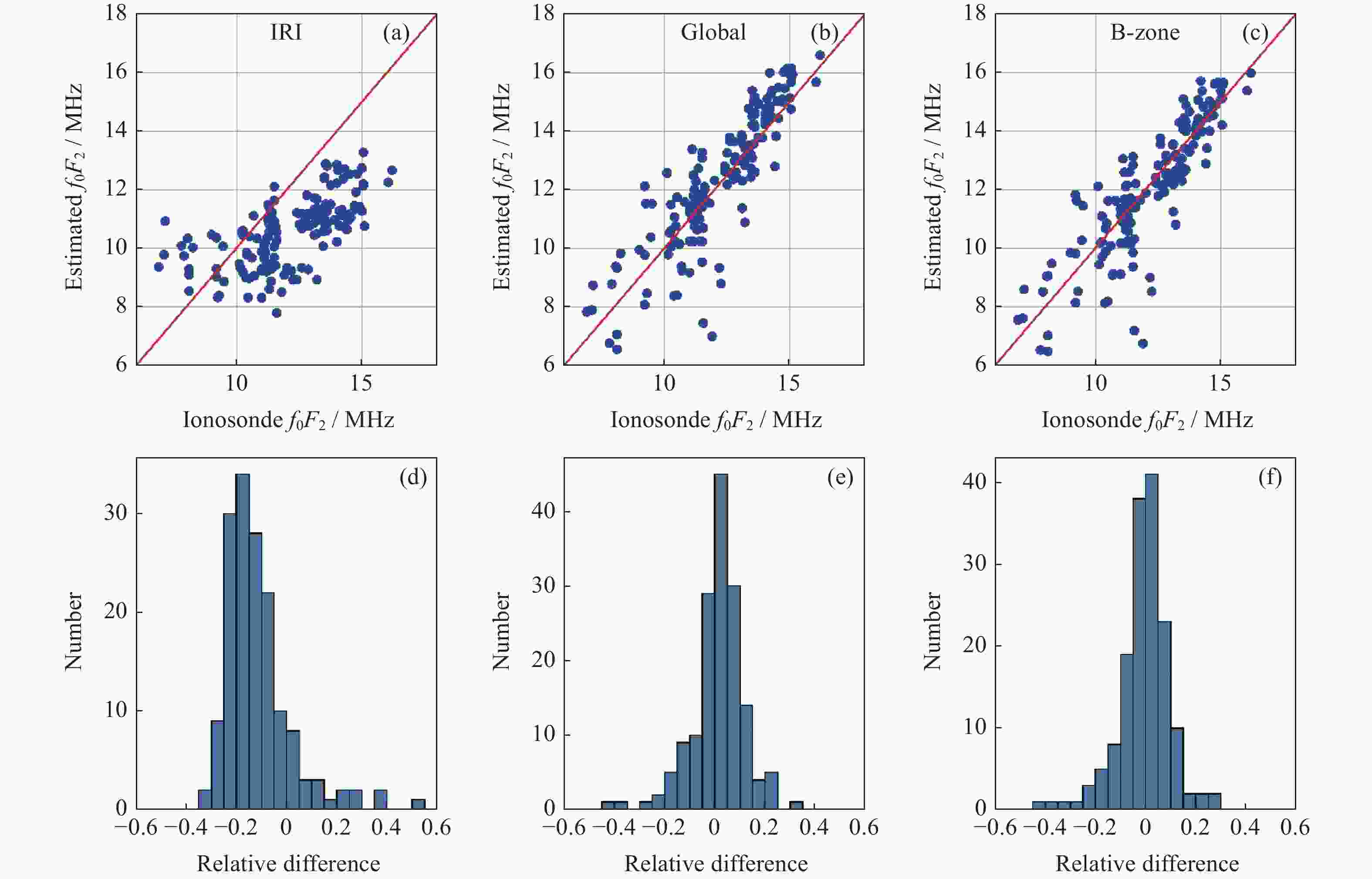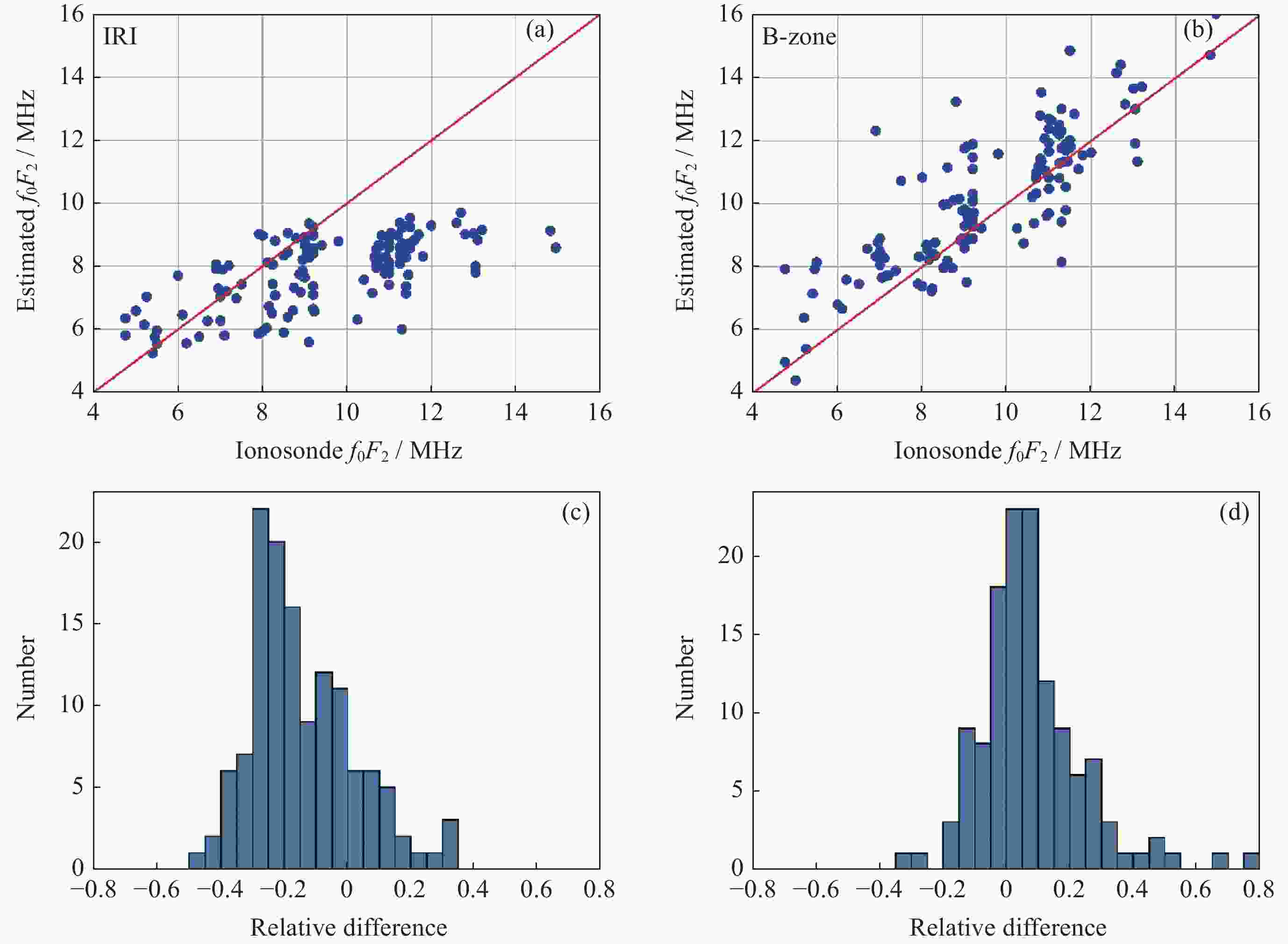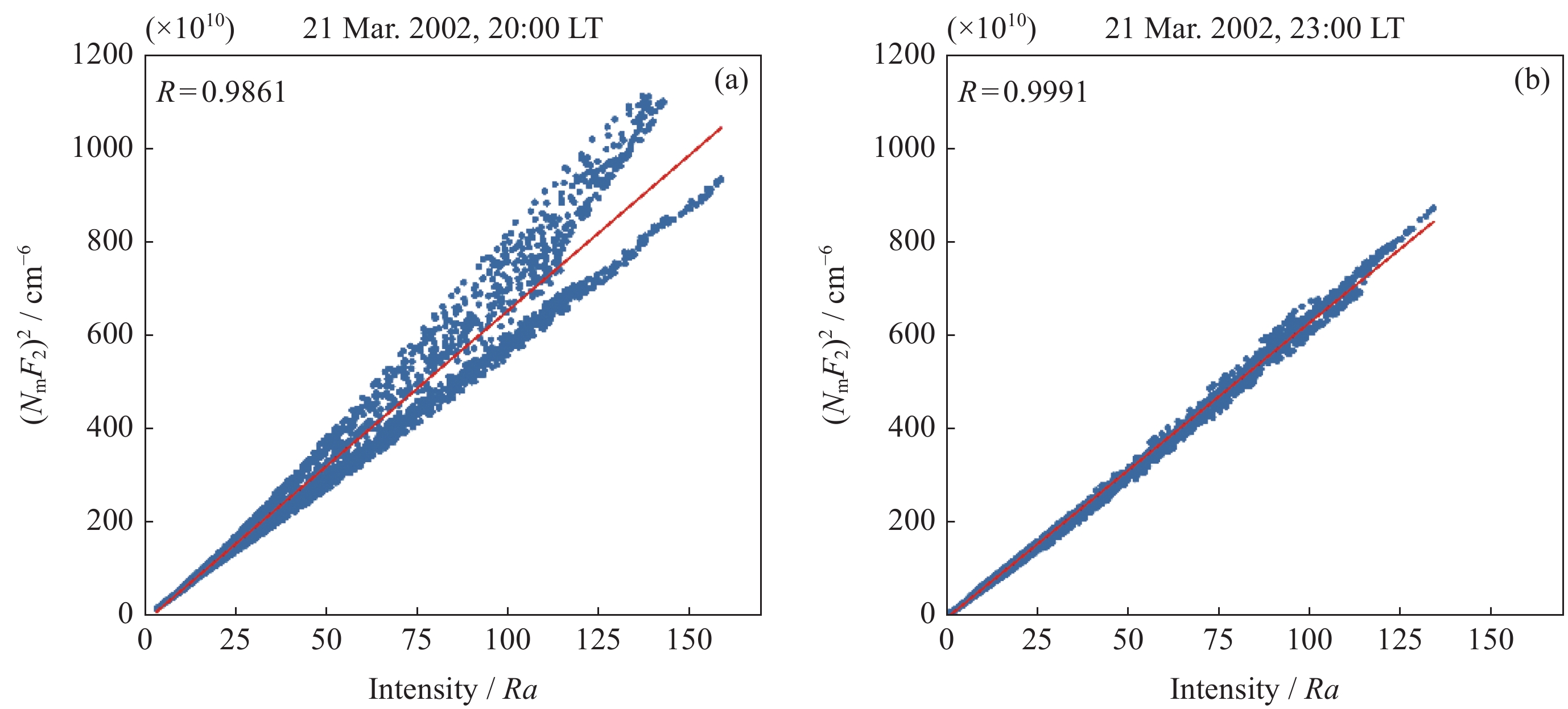夜间135.6 nm气辉反演的电离层f0F2与测高仪观测比较研究
doi: 10.11728/cjss2023.03.2022-0018 cstr: 32142.14.cjss2023.03.2022-0018
A Comparative Study between the Ionospheric f0F2 from Nighttime OI 135.6 nm Emission and Ionosonde Observations
-
摘要: 在夜间电离层,气辉135.6 nm谱线主要由F层的O+和电子的辐射复合过程以及O+和O–的中性复合过程激发,该谱线强度和电离层峰值电子密度NmF2存在很强的相关性。利用夜气辉135.6 nm辐射强度与F2层峰值电子密度NmF2的平方成正比的物理模型,建立了在不同经纬度、地方时、季节和太阳活动下均适用的反演算法。通过DMSP卫星上搭载的紫外光谱成像仪(SSUSI)实际观测的135.6 nm气辉辐射强度来反演相应时空的电离层F2层临界频率f0F2,并将其与地基测高仪探测结果做了综合对比。结果表明,在太阳活动高年(2013年),相对误差小于等于20%的数据占比93.0%,平均相对误差约为7.08%;在太阳活动低年(2017年),相对误差小于等于20%的数据占比80.8%,平均相对误差约为12.64%。最后,对该算法在太阳活动高低年的反演精度差异进行了分析。
-
关键词:
- OI 135.6 nm /
- 反演方法 /
- f0F2 /
- 电离层 /
- 测高仪
Abstract: The ionosphere is the part of the upper atmosphere which is ionized by solar radiation. There are a variety of ground-based and space-based remote sensing and in situ instruments to study the ionosphere. Recently, an effective method, called passive optical remote sensing technique, is widely used to study the ionosphere. It utilizes natural airglow (atoms and molecules frequently emit light to shed their excess energy) in the ionosphere. In the electromagnetic spectrum, the far ultraviolet light emissions are prominent in the ionosphere and could be used to monitor the ionosphere. During the nighttime, the 135.6 nm spectral line is excited by the radiation recombination process of F region O+ and e– and the mutual neutralization process of O+ and O– in the ionosphere. There is a strong correlation between the intensity of the spectral line and the maximum electronic density of ionospheric F2 layer (NmF2). Based on the physical model in which the OI 135.6 nm emission is proportional to the square of NmF2, the retrieval algorithm is established for different longitude, latitude, local time, season and solar activity. In this paper, the critical frequency of ionospheric F2 region (f0F2) is retrieved from 135.6 nm emission observed by the Special Sensor Ultraviolet Spectrographic Imager (SSUSI) instrument on board the Defense Meteorological Satellite Program (DMSP), and then the estimated results are compared with the detection results of ground-based ionosonde. As the results show, during the high-solar activity year (2013), the data with relative error less than or equal to 20% accounted for 93.0%, and the average relative error is about 7.08%. During the low-solar activity years (2017), the data with relative error less than or equal to 20% accounted for 80.8%, and the average relative error is about 12.64%. Finally, we analyze the difference of retrieval accuracy of the algorithm during the high and low solar activity years.-
Key words:
- OI 135.6 nm /
- Retrieval method /
- f0F2 /
- Ionosphere /
- Ionosonde
-
图 3 OI 135.6 nm夜气辉辐射强度与NmF2平方在不同区域的拟合(R表示线性相关系数,红色实线为两类数据的线性拟合)。(a)全球区域,(b)A区,(c)B区
Figure 3. Linear fitting of the OI 135.6 nm emission and the square of NmF2 in different regions. R represents the linear correlation coefficient, and the red solid line indicates the linear fitting of the two data. (a) Global-zone, (b) A-zone, (c) B-Zone
图 6 2013年估计的f0F2与地基探测f0F2的对比。(a)IRI f0F2,(b)使用Global换算系数反演的f0F2,(c)使用 B 区换算系数反演的f0F2,(d)~(f)相对误差的统计直方图。地点为海南富克站(19.53°N,109.13°E)
Figure 6. Comparison between estimated f0F2 and f0F2 detected by ionosonde in 2013. (a) IRI f0F2, (b) f0F2 retrieved from Global conversion factor, (c) f0F2 retrieved from B-zone conversion factor, (d)~(f) statistical histogram of relative difference. The location is Hainan Fuke station (19.53°N, 109.13°E)
图 7 2017年估计的f0F2与地基探测f0F2的对比。(a)IRI f0F2,(b)使用B区换算系数反演的f0F2,(c)~(d)相对误差的统计直方图。地点为海南富克站(19.53°N,109.13°E)
Figure 7. Comparison between estimated f0F2 and f0F2 detected by ionosonde in 2017. (a) IRI f0F2, (b) f0F2 retrieved from B-zone conversion factor, (c)~(d) statistical histogram of relative difference. The location is Hainan Fuke station (19.53°N, 109.13°E)
表 1 复合反应和复合系数
Table 1. Recombination reaction and recombination coefficient
复合反应 复合系数 $ {\mathrm{O}}^{+}+\mathrm{e}\to \mathrm{O}+hv\left(1356 Å \right) $ $ {\alpha }_{135.6}=7.3\times {10}^{-13}(1160/{T}_{\mathrm{e}}{)}^{1/2}\;\mathrm{c}{\mathrm{m}}^{3}\cdot {\mathrm{s}}^{-1} $ $ \mathrm{O}+\mathrm{e}\to {\mathrm{O}}^{-}+hv $ $ {k}_{1}=1.3\times {10}^{-15}\;\mathrm{c}{\mathrm{m}}^{3}\cdot {\mathrm{s}}^{-1} $ $ {\mathrm{O}}^{+}+{\mathrm{O}}^{-}\to {\mathrm{O}}'+\mathrm{O}\left(1356 Å \right) $ $ \begin{array}{c}{k}_{2}=1.0\times {10}^{-7}\;{\rm{c}}{\mathrm{m}}^{3}\cdot {\mathrm{s}}^{-1},{\beta }_{135.6}=0.54\end{array} $ $ \mathrm{O}+{\mathrm{O}}^{-}\to {\mathrm{O}}_{2}+\mathrm{e} $ $ {k}_{3}=1.4\times {10}^{-10}\;\mathrm{c}{\mathrm{m}}^{3}\cdot {\mathrm{s}}^{-1} $ 注 ${\rm{O}}' $表示激发态的氧原子O(5S)。 -
[1] WANG Houmao, WANG Yongmei. Airglow simulation based on the atmospheric ultraviolet radiance integrated code of 2012[J]. Science China: Earth Sciences, 2016, 59(2): 425-435 doi: 10.1007/s11430-015-5166-7 [2] STRICKLAND D J, DONAHUE T M. Excitation and radiative transport of OI 1304 Å resonance radiation—I: The dayglow[J]. Planetary and Space Science, 1970, 18(5): 661-689 doi: 10.1016/0032-0633(70)90049-8 [3] STRICKLAND D J, ANDERSON JR D E. Radiation transport effects on the OI 1356‐Å limb intensity profile in the dayglow[J]. Journal of Geophysical Research: Space Physics, 1983, 88(A11): 9260-9264 doi: 10.1029/JA088iA11p09260 [4] CHANDRA S, REED E I, MEIER R R, et al. Remote sensing of the ionospheric F layer by use of O I 6300-Å and O I 1356-Å observations[J]. Journal of Geophysical Research, 1975, 80(16): 2327-2332 doi: 10.1029/JA080i016p02327 [5] MEIER R R, OPAL C B. Tropical UV arcs: Comparison of brightness with f0F2[J]. Journal of Geophysical Research, 1973, 78(16): 3189-3193 doi: 10.1029/JA078i016p03189 [6] MEIER R R. Ultraviolet spectroscopy and remote sensing of the upper atmosphere[J]. Space Science Reviews, 1991, 58(1): 1-185 [7] DEMAJISTRE R, PAXTON L J, MORRISON D, et al. Retrievals of nighttime electron density from Thermosphere Ionosphere Mesosphere Energetics and Dynamics (TIMED) mission Global Ultraviolet Imager (GUVI) measurements[J]. Journal of Geophysical Research: Space Physics, 2004, 109(A5): A05305 [8] PAXTON L J, MENG C I, FOUNTAIN G H, et al. Special sensor ultraviolet spectrographic imager: an instrument description[C]//Proceedings of SPIE 1745, Instrumentation for Planetary and Terrestrial Atmospheric Remote Sensing. San Diego: SPIE, 1992: 2-15 [9] CHRISTENSEN A B, PAXTON L J, AVERY S, et al. Initial observations with the Global Ultraviolet Imager (GUVI) in the NASA TIMED satellite mission[J]. Journal of Geophysical Research: Space Physics, 2003, 108(A12): 1451 doi: 10.1029/2003JA009918 [10] DYMOND K F, NEE J B, THOMAS R J. The tiny ionospheric photometer: an instrument for measuring ionospheric gradients for the COSMIC constellation[J]. Terrestrial, Atmospheric and Oceanic Sciences, 2000, 11(1): 273-290 doi: 10.3319/TAO.2000.11.1.273(COSMIC) [11] MENDE S B, FREY H U, RIDER K, et al. The far ultra-violet imager on the ICON mission[J]. Space Science Reviews, 2017, 212(1): 655-696 [12] JIANG F, MAO T, ZHANG X X, et al. Observation of thermosphere and ionosphere using the ionosphere PhotoMeter (IPM) on the Chinese meteorological satellite FY-3D[J]. Advances in Space Research, 2020, 66(9): 2151-2167 doi: 10.1016/j.asr.2020.07.027 [13] STRICKLAND D J, BISHOP J, EVANS J S, et al. Atmospheric Ultraviolet Radiance Integrated Code (AURIC): theory, software architecture, inputs, and selected results[J]. Journal of Quantitative Spectroscopy and Radiative Transfer, 1999, 62(6): 689-742 doi: 10.1016/S0022-4073(98)00098-3 [14] BISHOP J, FELDMAN P D. Analysis of the astro-1/Hopkins ultraviolet telescope EUV–FUV dayside nadir spectral radiance measurements[J]. Journal of Geophysical Research: Space Physics, 2003, 108(A6): 1243 doi: 10.1029/2001JA000330 [15] STEPHAN A W, DYMOND K F, BUDZIEN S A, et al. Middle ultraviolet remote sensing of the equatorial thermosphere during a geomagnetic storm[J]. Annales Geophysicae, 2004, 22(9): 3203-3209 doi: 10.5194/angeo-22-3203-2004 [16] EVANS J S, LUMPE J D, CORREIRA J, et al. Extension of the AURIC radiative transfer model for mars atmospheric research[C]//AGU Fall Meeting 2013. Washington: American Geophysical Union, 2013: P21 A-1686 [17] 江芳, 毛田, 李小银, 等. 利用OI 135.6 nm夜气辉辐射探测电离层峰值电子密度及电子总含量的研究[J]. 地球物理学报, 2014, 57(11): 3679-3687JIANG Fang, MAO Tian, LI Xiaoyin, et al. The research on NmF2 and TEC derived from nighttime OI 135.6 nm emission measurement[J]. Chinese Journal of Geophysics, 2014, 57(11): 3679-3687 [18] DING G X, CHEN B, ZHANG X X, et al. A method to derive global O/N2 ratios from SSUSI/DMSP based on Re-AURIC algorithm[J]. Journal of Atmospheric and Solar-Terrestrial Physics, 2020, 199: 105196 doi: 10.1016/j.jastp.2020.105196 [19] QIN J Q, MAKELA J J, KAMALABADI F, et al. Radiative transfer modeling of the OI 135.6 nm emission in the nighttime ionosphere[J]. Journal of Geophysical Research: Space Physics, 2015, 120(11): 10116-10135 doi: 10.1002/2015JA021687 [20] BRUNE W H, FELDMAN P D, ANDERSON R C, et al. Midlatitude oxygen ultraviolet nightglow[J]. Geophysical Research Letters, 1978, 5(5): 383-386 doi: 10.1029/GL005i005p00383 [21] DYMOND K F, THONNARD S E, MCCOY R P, et al. An optical remote sensing technique for determining nighttime F region electron density[J]. Radio Science, 1997, 32(5): 1985-1996 doi: 10.1029/97RS01887 [22] DYMOND K F, NICHOLAS A C, BUDZIEN S A, et al. A comparison of electron densities derived by tomographic inversion of the 135.6-nm ionospheric nightglow emission to incoherent scatter radar measurements[J]. Journal of Geophysical Research: Space Physics, 2019, 124(6): 4585-4596 doi: 10.1029/2018JA026412 [23] CHAMBERLAIN J W, HUNTEN D W. Theory of Planetary Atmospheres: An Introduction to Their Physics and Chemistry [M]. New York: Academic Press Inc. , 1987 [24] BILITZA D, ALTADILL D, TRUHLIK V, et al. International reference ionosphere 2016: from ionospheric climate to real-time weather predictions[J]. Space Weather, 2017, 15(2): 418-429 doi: 10.1002/2016SW001593 [25] PICONE J M, HEDIN A E, DROB D P, et al. NRLMSISE-00 empirical model of the atmosphere: statistical comparisons and scientific issues[J]. Journal of Geophysical Research: Space Physics, 2002, 107(A12): 1468 [26] RAJESH P K, LIU J Y, HSU M L, et al. Ionospheric electron content and NmF2 from nighttime OI 135.6 nm intensity[J]. Journal of Geophysical Research: Space Physics, 2011, 116(A2): A02313 [27] QIN J Q. Far ultraviolet remote sensing of the nighttime ionosphere using the OI 130.4-nm emission[J]. Journal of Geophysical Research: Space Physics, 2020, 125(6): e2020JA028049 [28] GUO B, XU J Y, SUN L C, et al. The seasonal and longitudinal variations of nighttime OI 135.6-nm emission at equatorial ionization anomaly crests observed by the DMSP/SSUSI[J]. Journal of Geophysical Research: Space Physics, 2020, 125(9): e2019JA027764 [29] TSAI T C, JHUANG H K, LEE L C, et al. Ionospheric peaked structures and their local time, seasonal, and solar activity dependence based on global ionosphere maps[J]. Journal of Geophysical Research: Space Physics, 2019, 124(10): 7994-8014 doi: 10.1029/2019JA026899 [30] SHEPHERD S G. Altitude-adjusted corrected geomagnetic coordinates: definition and functional approximations[J]. Journal of Geophysical Research: Space Physics, 2014, 119(9): 7501-7521 doi: 10.1002/2014JA020264 -
-





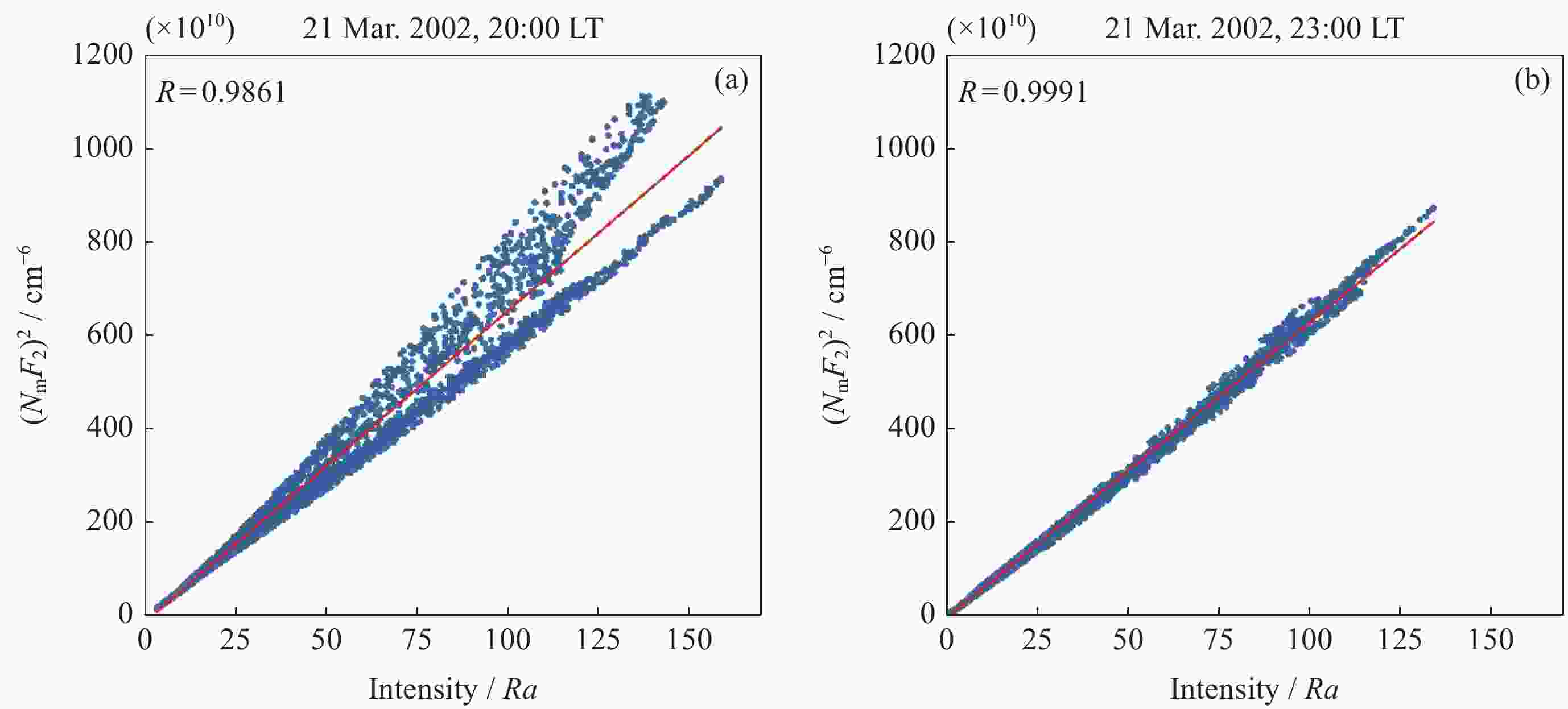
 下载:
下载:
